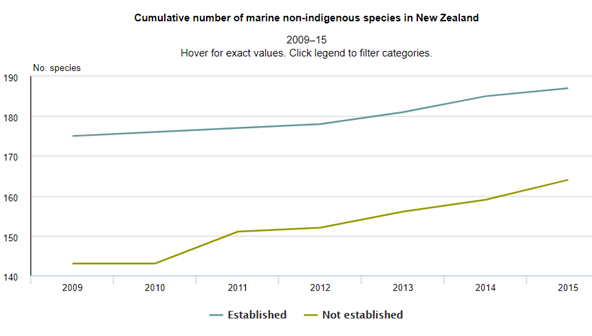Invasive marine species
Marine pests are species that are not indigenous to New Zealand, which have been introduced to our waters by human activities (as well as less-commonly through natural dispersal), and which have the potential to significantly damage marine ecosystems and species.
Many marine invasive species have become established in New Zealand. Some have been in the country for a long time, such as the Pacific oyster. Others are more recent arrivals, such as Undaria pinnatifida (Japanese kelp). Both the Pacific oyster and Japanese kelp are now well-established and have been adopted into the country’s aquaculture industry.
In 2015, 351 non-indigenous species were identified in New Zealand marine waters, of which 187 had become established. 06800210-5d6c-4568-800b-e48550ced6d1 These include algae (both large and microscopic), barnacles, crabs, bryozoans, sea squirts, mussels and othermolluscs. The cumulative number of species in New Zealand waters in 2015 has risen by 10 percent since 2009. The graph below shows the cumulative number of marine non-indigenous species discovered in New Zealand over time. It is worth noting that at least part of the significant rise in the number of detections between 2001 and 2010 is likely due to the active surveillance programmes put in place during that period, and greater awareness of the negative impacts of marine pests. It is worth noting that at least part of the significant rise in the number of detections between 2001 and 2010 is likely due to the active surveillance programmes put in place during that period, and greater awareness of the negative impacts of marine pests.

The Ministry for Primary Industries has identified eleven unwanted marine organisms which are highly invasive and of particular concern:
- Asian paddle crab (Charybdis japonica)
- Chinese mitten crab (Eriocheir sinensis)
- European shore crab (Carcinus maenus)
- Mediterranean fanworm (Sabella spallazanii)
- Northern Pacific seastar (Asterias amurensis)
- Australian droplet tunicate (Eudistoma elongatum)
- Clubbed tunicate (Styela clava)
- Pyura (Pyura doppelgangera)
- Aquarium caulerpa (Caulerpa taxifolia)
- Wakame/Undaria (Undaria pinnatifida)
- Asian clam (Potamocorbula amurensis)
There are numerous diseases that affect New Zealand’s fish, molluscs and shellfish. Diseases can cause stocks to collapse, which in turn can affect the natural balance of an ecosystem. 47f1e7bb-f78e-4077-bc67-cef15964df8a Fish stock collapses can have severe effects on commercial, cultural and recreational fisheries and diseases may also be of concern to human health, such as, for example the Ostreid herpesvirus (OsHV-1) which is discussed further in the Aquaculture section.
The Ministry for Primary Industries (MPI), in collaboration with NIWA, has developed a new web portal called the Marine Biosecurity Porthole. bd0479aa-8863-4332-8ef4-02ec510ec180 This provides access to surveillance and other records of marine pests in New Zealand waters. These data come from a range of sources including a national series of Port Biological Baseline Surveys and the results of a Marine High Risk Site Surveillance programme (both which are discussed below), as well as NIWA’s Marine Invasive Taxonomic Service (which identifies marine specimens on behalf of MPI) and other verified observations. This portal plays an important role in distributing information about current knowledge on non-native marine organisms in New Zealand.
Additional information on marine pests can be found at the marine security porthole website here.
-
http://www.stats.govt.nz/browse_for_stats/environment/environmental-reporting-series/environmental-indicators/Home/Marine/marine-pests.aspx
-
http://www.biosecurity.govt.nz/biosec/camp-acts/marine-biosec-programme
-
https://catalogue.data.govt.nz/dataset/new-zealand-marine-biosecurity-porthole
-
https://www.mpi.govt.nz/dmsdocument/10478-new-zealand-marine-pest-id-guide
Last updated at 6:28PM on February 8, 2018